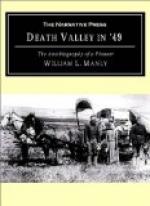The sun rose without a cloud, and a little later the sea breeze from the bay blew gently over the valley, making the climate perfectly delightful in its temperate coolness, a true paradise on earth it seemed to me, if I was able to judge or set a value upon so beautiful a spot; and surely I had seen all sorts, good and poor, desert and valley, mountain and plain.
But I was poor in purse, and resolved I would seek first the gold mines and secure gold enough to buy a piece of this valley afterward.
When I had seen what was to be seen about San Jose I had a talk with my friends and found that Mr. Bennett favored going on to the mines at once and that Moody and Skinner thought they would remain a little while at least.
I went along in company with Bennett, and when we got a little way from San Jose, on the road to the Mission, the road seemed walled in on both sides with growing mustard ten or twelve feet high and all in blossom. How so much mustard could grow, and grow so large, I could not understand. I had seen a few plants in the gardens or fields which people used for greens, and here seemed to be enough to feed the nation, if they liked mustard greens.
The second day out we passed the big church at Mission San Jose and soon left the valley and turned into the mountains and when part way over we came to a stream which we followed up and came out into Livermore valley, where we found a road to follow. Houses were scarce, and we camped a mile or so before we got to the Livermore ranch buildings. There was very little sign of life about the place, and we soon went out of the valley and into the mountains again.
The first sign of settlement we saw when part way through the mountains was a stone corral, but no house or other improvements. The next place was a small house made of willow poles set in the ground and plastered over with mud. This rejoiced in the name of “Mountain House.” This wayside inn looked like a horse thief’s glory; only one or two men, a quarter of an elk hanging on a pole, and no accommodations for man or beast. There was very little water, nothing to sell as well as nothing wanted. On the summits of the mountains as we passed through we saw, standing like guards, many large buck elks.




